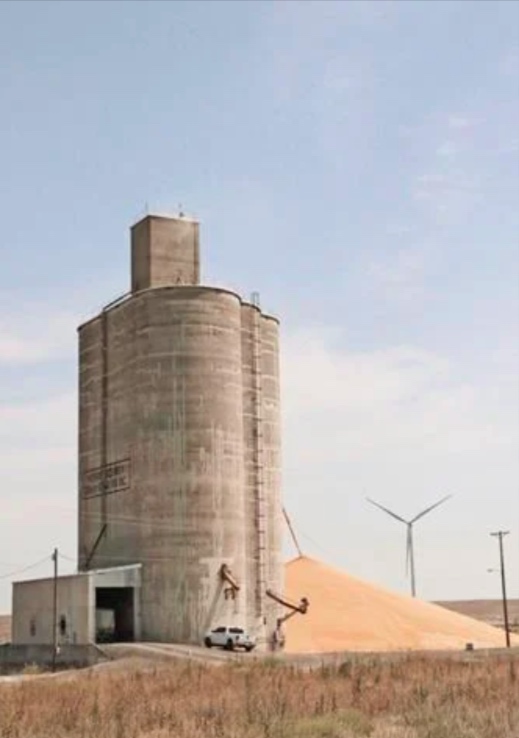forum
library
tutorial
contact

NW Wheat Harvest:
Yields and Exports Up, Prices Down
by Matthew WeaverCapital Press, August 2, 2024
|
the film forum library tutorial contact |

|
NW Wheat Harvest:
by Matthew Weaver |
The pace of soft white wheat and overall U.S. wheat sales is ahead of last year.
 As they reach the halfway point of harvest, Pacific Northwest wheat farmers report average to above-average yields -- they just wish the prices were higher, industry leaders say.
As they reach the halfway point of harvest, Pacific Northwest wheat farmers report average to above-average yields -- they just wish the prices were higher, industry leaders say.
Harvest in Oregon is average and on schedule, said Amanda Hoey, Oregon Wheat CEO.
"We have a crop that looks really good as it's coming out of the fields, especially the dryland areas," Hoey said. "We just had those timely, right-timed rains that benefited us certainly in both quantity and quality of wheat this year."
Harvest has been going in the Lewiston, Idaho, area for about three weeks, said Britany Hurst Marchant, executive director of the state's Wheat Commission. Some lower elevation dryland areas in southern Idaho started about that same time.
Harvest began in the Treasure Valley and Magic Valley about 10 days ago, she said.
Higher elevation areas are still green, just turning off or getting ready to turn off irrigation, and won't start harvesting for another month or so, Hurst Marchant said.
"However, the hot temperatures we have in the forecast will dry that wheat out faster if it doesn't cool off," she said.
In Washington, winter wheat is about 40% harvested and spring wheat is about 10% harvested, said Casey Chumrau, executive director of the Washington Grain Commission.
Winter wheat yields are average to above average in most areas, except for some drier areas, such as Grant, Adams and Franklin counties, she said.
"Overall, the soft white winter wheat has not been affected by the July heat, and its protein levels are within the desirable range," Chumrau said. "Spring wheat, however, may have lower yields and higher protein levels due to the heat. This could help balance out some areas of low winter wheat protein for customers."
Reports indicate no falling number issues and test weights above 60 pounds per bushel, which is the target, Chumrau said. Falling number tests indicate starch damage.
Price 'challenging'
"Price is really challenging," Hoey said. "It's a couple dollars below this point last year, a couple dollars below that from the year prior. We keep seeing that decline as we see a lot of wheat come out of the Black Sea and other competitor areas that have had some good harvests."
Soft white wheat traded from $5.65 per bushel to $5.90 per bushel on the Portland market.
Hoey also pointed to the strong U.S. dollar. The dollar was worth 147 Japanese yen the morning of Aug. 2. The value of the yen is down 43% since 2021.
"Prices have dropped to the lowest level since before the Russian invasion of Ukraine in early 2021, and similar to the price received in 2008," Chumrau said. "As with every other industry, production costs have increased significantly in the last few years, and certainly since 2008. Low prices create significant amount of risk and stress for farmers."
The cost of production varies for each farm, Hoey said.
"Is the price sufficient to cover production?" she said. "I don't think we are. Producers are definitely in a challenge position when you look at the price of wheat, the increasing costs on interest rates and inflationary costs on the cost of production itself."
Exports increase
The lower prices, however, mean U.S. wheat is more competitive on the world market.
"The export numbers have definitely been going the right direction," Hoey said, calling it a "buyer-centered price."
"We're in a better place this marketing year, which started June 1. Last year was a really challenging marketing year," she said.
The pace of soft white wheat and overall U.S. wheat sales is ahead of last year, Chumrau said, with South Korea doing some "aggressive" feed wheat purchasing, which has put their sales-to-date "way ahead" of normal.
Other issues
The three wheat leaders aren't reporting much disease or heat pressure so far.
"The hot temperatures definitely stress the plant, but that can be beneficial if the heat doesn't come on too fast or too early," Hurst Marchant said. "The high temperatures came at the right time to dry out the crop without causing yield losses or quality issues. We have seen some damage from the late season frosts that resulted in substantial yield losses in the hardest hit pockets of the state."
Hurst Marchant also issued a precautionary note to growers.
"It's a hot, dry year with poor air quality as a result of the fires throughout the PNW, so like always we encourage farmers to make sure they are taking appropriate precautions even though they are running hard to take care of their farms," she said. "It's always a good reminder that the farmer is the most valuable asset and should be the farm's first priority."
learn more on topics covered in the film
see the video
read the script
learn the songs
discussion forum
